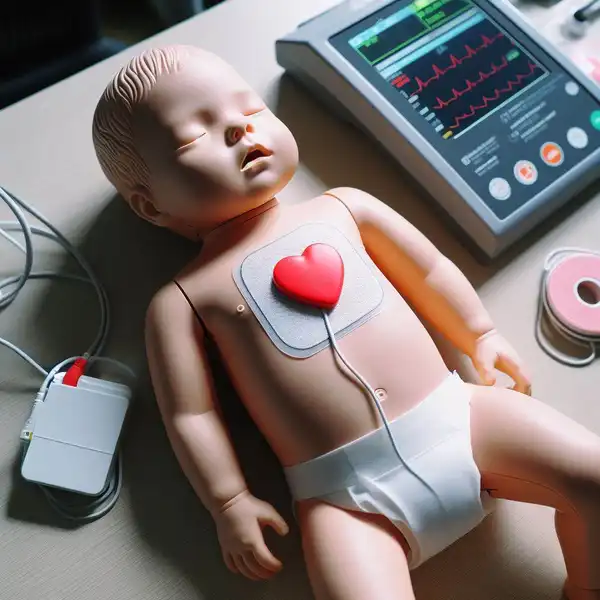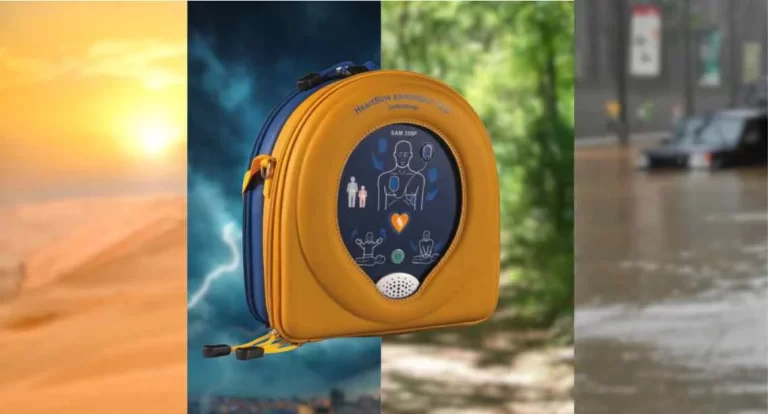Can Defibrillators Be Used on Infants?
Today, we’re tackling a topic that might surprise you: using defibrillators on infants. When you think of Defibrillators you might imagine someone more advanced in years. However, even our tiniest humans sometimes need a shock to keep their hearts ticking. So, let’s dive into the world of infant defibrillation and explore when, why, and how to use these life-saving devices on the littlest members of our community.
Why Might Infants Need Defibrillation?
First things first, let’s talk about why an infant might need defibrillation. Just like adults, infants can experience sudden cardiac arrest (SCA) – a condition where the heart abruptly stops beating effectively. While SCA is less common in infants compared to adults, it can still happen due to various causes, such as:
- Congenital heart defects: Some babies are born with structural abnormalities in their hearts that can lead to rhythm disturbances and SCA.
- Respiratory issues: Infants are particularly susceptible to breathing problems, which can cause a lack of oxygen to the heart and trigger SCA.
- Infections: Severe infections, such as sepsis or myocarditis (inflammation of the heart muscle), can disrupt the heart’s normal rhythm and lead to SCA in infants.
- Accidents or trauma: In rare cases, accidents or traumatic events can cause SCA in infants.
When an infant experiences SCA, their heart stops pumping blood effectively, and they lose consciousness. Without prompt intervention, including CPR and defibrillation, the infant’s brain and other vital organs can suffer permanent damage or even death.
Recap: Can infants experience sudden cardiac arrest?
Yes, although less common than in adults, infants can suffer from sudden cardiac arrest due to congenital heart defects, respiratory issues, infections, or trauma.
How to Use a Defibrillator on an Infant
Now that we know why infants might need defibrillation let’s talk about how to use a defibrillator on these tiny patients. The good news is that many modern defibrillators, such as the Lifepak CR2, come equipped with a child mode that delivers an infant-appropriate shock.
To use a defibrillator on an infant, follow these steps:
- Confirm unconsciousness: Check if the infant is responsive by speaking loudly and touching them trying to wake them. If there’s no response, proceed with the following steps.
- Call for help: If you’re alone, call for emergency medical services and grab the nearest defibrillator. If someone else is with you, have them call for help while you start CPR.
- Begin CPR: Start chest compressions at a rate of 100-120 per minute, using two fingers for infants. Give 30 compressions followed by 2 puffs of air in to their mouth (Seal your mouth over their nose and mouth), and continue this cycle until the defibrillator is ready.
- Turn on the defibrillator and activate child mode: Power on the defibrillator and look for the child mode button. On the Lifepak CR2, for example, you’ll press a clearly labeled button to switch to child mode, which delivers a lower energy shock suitable for infants.
- Attach the pads: For infants, the defibrillator pads should be placed in the front and back position. Place one pad on the center of the chest, just below the nipple line. Place the other pad on the back, between the shoulder blades.
- Analyze the rhythm and deliver the shock: Once the pads are attached, let the defibrillator analyze the infant’s heart rhythm. If a shockable rhythm is detected, ensure that no one is touching the infant, then press the shock button. The defibrillator will deliver an infant-appropriate shock.
- Resume CPR: Immediately after the shock, resume CPR, starting with chest compressions. Continue the cycle of 30 compressions and 2 breaths until emergency medical help arrives or the infant shows signs of life (breathing, moving, or crying).
Recap: How do you use a defibrillator on an infant?
To use a defibrillator on an infant, activate the child mode (if available), place one pad on the center of the chest and the other on the back, and follow the defibrillator’s prompts.
Pad Placement for Infant Defibrillation

One crucial aspect of using a defibrillator on an infant is proper pad placement. For infants, the front-and-back pad position is recommended to ensure the most effective current pathway through the heart. Here’s a more detailed explanation:
- Front pad: Place one pad in the center of the chest.
- Back pad: Place the other pad on the infant’s back, between the shoulder blades. This pad should be centered on the spine.
The front-and-back position allows the electrical current to travel through the heart from front to back, maximizing the chances of successfully restoring a normal heart rhythm.
Child Mode: Delivering Infant-Appropriate Shocks
Many modern defibrillators, like the Lifepak CR2, come with a built-in child mode that adjusts the energy level of the shock to be appropriate for infants and young children. This feature is crucial because infants have smaller bodies and require lower energy shocks compared to adults.
To activate the child mode on the Lifepak CR2, simply press the clearly labeled child mode button. The defibrillator will then adjust the shock energy to a level suitable for infants. Some other defibrillator models may have a similar button or a switch to change between adult and child modes.
What if your defibrillator doesn’t have a child mode? Give a shock anyway. In cardiac arrest every seconds count, it’s better to give a shock as soon as possible rather than wait for an ambulance to come and defibrillate.
When in doubt, always refer to the specific instructions provided with the defibrillator you are using. Familiarizing yourself with the device before an emergency situation arises can save valuable time and ensure that you’re prepared to deliver the best possible care to an infant in need.
Recap: How do you deliver an infant-appropriate shock with a defibrillator?
Many defibrillators, such as the Lifepak CR2, have a child mode that can be activated by pressing a clearly labeled button. This mode adjusts the shock energy to a level suitable for infants. Always refer to the specific instructions provided with the defibrillator you are using.
The Bottom Line
Defibrillators can indeed be used on infants, and knowing how to do so could mean the difference between life and death for a tiny heart in distress. By understanding the reasons infants might need defibrillation, the steps to using a defibrillator on an infant, proper pad placement, and the importance of child mode, you can be prepared to provide life-saving care in an emergency.
Remember, while defibrillators are designed to be user-friendly, it’s always best to familiarize yourself with the device and its features before an emergency strikes. If your community or workplace has a defibrillator, take the time to read the instructions and locate the child mode button.
In the event that you need to use a defibrillator on an infant, stay calm, follow the steps, and trust in the power of this incredible, life-saving technology. With your quick thinking and the defibrillator’s tiny shock, you could be the hero that a little heart needs! If you’d like to learn more about defibrillators and their functions read our article here.





